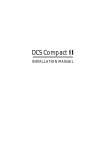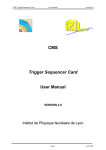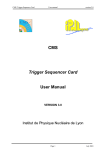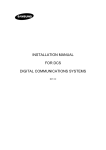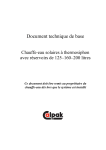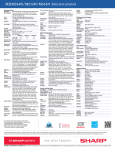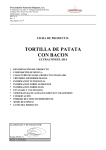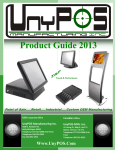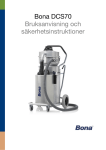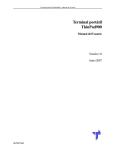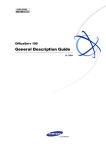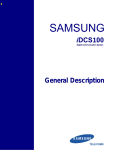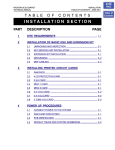Download INSTALLATION MANUAL FOR THE SAMSUNG
Transcript
INSTALLATION MANUAL FOR THE SAMSUNG DCS 70 DIGITAL COMMUNICATIONS SYSTEMS REV 02 th SAMSUNG DCS 70 INSTALLATION MANUAL 10 January, 2000 TABLE OF CONTENTS CHAPTER ONE................................................................................................................... : INTRODUCTION 1-1 CHAPTER TWO........................................................................................................: SITE REQUIREMENTS 2-1 CHAPTER THREE................................................................................... : INSTALLATION OF THE DCS 70 3-1 UNPACKING AND INSPECTION..................................................................................................................... 3-1 KEY SERVICE UNIT INSTALLATION............................................................................................................ 3-1 EXPANSION CABINET INSTALLATION ....................................................................................................... 3-1 PROTECTIVE EARTHING ................................................................................................................................ 3-2 DISTRIBUTION FRAME CABLING................................................................................................................. 3-3 CHAPTER FOUR ...................................................................: INSTALLING CARDS IN THE DCS 70 KSU 4-1 KSU MOTHERBOARD ............................................................................................................................................ 4-1 MEMORY (MEM) CARD ....................................................................................................................................... 4-1 3 TRK CARD (3TRKD70) .................................................................................................................................. 4-2 6 TRK CARD (6TRKD70) .................................................................................................................................. 4-2 4 TRK CARD (4TRK24) ..................................................................................................................................... 4-2 6 TRK CARD (6TRK24) ..................................................................................................................................... 4-2 2 SLI-C CARD ..................................................................................................................................................... 4-3 MISC1&2 CARDS (MISC1D70 / MISC2D70) .................................................................................................. 4-3 MODEM CARD (MODEMD70) ......................................................................................................................... 4-3 8 DLI CARD (8DLID70) ..................................................................................................................................... 4-3 8 SLI CARD (8SLID70)....................................................................................................................................... 4-4 6 MWSLI CARD (6MWSLID70) ........................................................................................................................ 4-4 4BRI CARD (4BRID70) ...................................................................................................................................... 4-4 PRI CARD (DCS CARD) ...................................................................................................................................... 4-5 PLL BOARD (PLLD70)......................................................................................................................................... 4-5 VDIAL CARD (VDIAL-C) (DCS COMPACT CARD) ............................................................................................ 4-5 BSI CARD (DECTBSI-C) (DCS COMPACT CARD) ............................................................................................. 4-5 E&M TIE LINE CARD (EMTIEBDD70) ........................................................................................................... 4-5 LINE REVERSALS, PRS HYBRIDS & TRANSIT CONNECTIONS ............................................................... 4-5 METER PULSE MPD HYBRIDS ....................................................................................................................... 4-6 FITTING MPD & PRS HYBRIDS ...................................................................................................................... 4-6 MODIFYING THE 3TRKD70 AND 6TRKD70 CARDS FOR USE WITH PRS HYBRIDS ............................ 4-7 MODIFYING THE 4TRK24 AND 6TRK24 CARDS FOR USE WITH PRS HYBRIDS.................................. 4-7 NOTE : AUTOGUARD ON THE 3TRK, 4TRK24 & 6TRK(D70&24) CARDS ............................................... 4-8 DCS 70 POWER SUPPLY & FUSING ............................................................................................................... 4-8 POWERING UP THE SYSTEM ......................................................................................................................... 4-8 POWER UP PROBLEMS.................................................................................................................................... 4-9 MEM CARD INDICATIONS.............................................................................................................................. 4-9 DEFAULT TRUNK AND STATION NUMBERING......................................................................................... 4-9 CHAPTER FIVE .............................................................................................. : DCS 70 - SYSTEM CABLING SAFETY PRECAUTIONS................................................................................................................................... 5-1 SYSTEM CABLING............................................................................................................................................ 5-1 DCS 70 DISTRIBUTION FRAME CIRCUIT ALLOCATION .......................................................................... 5-2 TAIL 1 CIRCUIT ALLOCATION (KSU MOTHERBOARD TAIL). ............................................................ 5-2 Tail 1 - First 25 Pair ......................................................................................................................................... 5-2 Tail 1 - Second 25 Pair..................................................................................................................................... 5-3 i 5-1 th SAMSUNG DCS 70 INSTALLATION MANUAL 10 January, 2000 3 & 6 TRK CARD CONNECTIONS................................................................................................................... 5-3 8 DLI CARD CONNECTIONS .....................................................................................................................................5-4 8 SLI & 6MWSLI CARD CONNECTIONS .................................................................................................................5-5 BRI ISDN CARD CONNECTIONS..............................................................................................................................5-6 DECT BSI CARD CONNECTIONS .............................................................................................................................5-7 3 & 6 TRK CARD CONNECTIONS................................................................................................................... 5-8 8 DLI CARD CONNECTIONS .....................................................................................................................................5-9 8 SLI & 6MWSLI CARD CONNECTIONS ...............................................................................................................5-10 BRI ISDN CARD CONNECTIONS............................................................................................................................5-11 DECT BSI CARD CONNECTIONS ............................................................................................................. 5-12 CHAPTER SIX................................................. CONNECTING STATION AND OPTIONAL EQUIPMENT 6-1 CONNECTING ANCILLARY EQUIPMENT TO THE SYSTEM..................................................................... 6-1 MUSIC ON HOLD / BACKGROUND MUSIC.............................................................................................. 6-1 EXTERNAL PAGING..................................................................................................................................... 6-2 COMMON BELL ............................................................................................................................................ 6-2 RING OVER PAGE......................................................................................................................................... 6-3 STATION MESSAGE DETAIL RECORDER (SMDR)................................................................................. 6-3 SYSTEM PROGRAMMING FROM A PC (PCMMC)................................................................................... 6-3 REMOTE PROGRAMMING .......................................................................................................................... 6-4 DCS 70 REMOTE PROGRAMMING MODEM CONNECTION:..................................................................................... 6-4 DCS70 Programming Required: ...................................................................................................................... 6-4 Using an external Modem: ............................................................................................................................... 6-4 Set up external modem:.................................................................................................................................... 6-5 REMOTE PROGRAMMING USING INTERNAL OR EXTERNAL MODEM: ..................................................................... 6-5 CHAPTER SEVEN ................................................................: CHANGING SOFTWARE ON THE DCS - 70 7-6 ACCESSING THE EPROMS.......................................................................................................................... 7-6 REPLACING THE EPROMS.......................................................................................................................... 7-6 CHAPTER EIGHT........................................................................................................... : DCS 70 PARTS LIST ii 8-1 th SAMSUNG DCS 70 INSTALLATION MANUAL 10 January, 2000 Chapter One : Introduction This manual describes the procedure to install the Key Service Unit, keysets, single line telephones and ancillary equipment for the DCS 70 Digital Communication System. This manual covers the hardware installation and cabling only. The system programming and configuration is described in the DCS Installation and Maintenance Manual and in the System Administrators manual. The operation of the keysets and the single line telephones (SLT’s) is described in the user guides. The Samsung DCS 70 system should only be installed by fully trained and qualified personnel. Page 1-1 th SAMSUNG DCS 70 INSTALLATION MANUAL 10 January, 2000 Chapter Two : Site Requirements The installation site for the Samsung DCS 70 System should meet the following requirements • The location for the key service unit (KSU) must provide enough space for easy installation and have adequate lighting. The Key Service Unit measures 57cm high by 36cm wide by 13cm deep. • Select a location that will minimize cable lengths. See the maximum cable length limits in Chapter 6. • The equipment should not be exposed to moisture, direct sunlight, corrosive fumes, dust, constant vibration or strong magnetic fields such as those generated by motors and copy machines. • A single phase, correctly earthed, 240V, 10Amp, 50Hz, AC General Purpose Outlet (GPO) must be provided within two metres of the KSU. The GPO must be easily accessible and kept clear of obstructions. Extension cords must not be used. A dedicated, separately fused circuit should be used to minimize the risk of other electrical equipment being connected that could adversely affect system operation. • Ensure that all wires and cable going to and coming from the KSU are properly routed. The cables should not cross fluorescent lights or run parallel with AC wires. • The equipment must be located in an environment that will remain within the Temperature range of 0oC to 45oC and 10% to 95% Relative Humidity, non-condensing. • Allow at least 30cm clearance on both sides and 30cm clearance on top of the KSU to ensure proper ventilation. Refer to Figure 2.1 • Do not install the KSU in close proximity to a fire sprinkler head or other sources of water. Meeting these requirements will help to ensure proper performance and greater life expectancy of the system. Immunity to Interference. The DCS 70 System has been designed to be immune to the levels of interference normally found within residential and commercial premises (for example, mains dips and breaks, electro-static discharge, overvoltages and transients, electromagnetic fields). It is the customer’s responsibility to provide an environment for the DCS 70 system, Keysets and cabling that does not contain excessive sources of interference that could affect the operation of the systems. Page 2-1 th SAMSUNG DCS 70 INSTALLATION MANUAL 10 January, 2000 Min 300 mm Min 300 mm Min 300 mm Max 1800 mm Min 380 mm Figure 2-1. Wall Mounting the KSU Page 2-2 th SAMSUNG DCS 70 INSTALLATION MANUAL 10 January, 2000 Chapter Three : Installation Of The DCS 70 UNPACKING AND INSPECTION After unpacking the KSU, inspect the unit for signs of physical damage. KSUs with any sign of physical damage should be returned to the supplier for replacement. Check to see that the KSU carton includes the following items: • DCS 70 Key Service Unit (KSU) which includes: • Memory card • 20W Ringer • Paper Mounting Template • Power cable • Wall-mount kit consisting of cable ties, four screws, spare fuses and Battery Backup cable The EXPANSION Cabinet is provided as an add-on option. If provided, check that the expansion cabinet carton includes the following: • Expansion Cabinet • Mounting screws and cable tie. KEY SERVICE UNIT INSTALLATION The Key Service Unit (KSU) must be wall-mounted in a vertical position. The KSU has 4 key holes on the sides of the KSU for wall mounting. See Figure 3.1 Use the mounting template supplied to position the screw holes correctly. Insert the screws but do not tighten. Position the KSU on to all screws at the same time and then lower the KSU so that it is secured in the Keyholes. Tighten all screws to complete the installation. (see Figure 3-1). The KSU should be mounted on a section of the wall capable of holding the weight of the system (approximately 12 Kg fully loaded including Expansion Cabinet) and cables. For example close to a stud or noggin. EXPANSION CABINET INSTALLATION The DCS 70 system is shipped from the factory equipped with the 008 motherboard, Memory card power supply and ringer. The expansion metal cabinet is an optional cabinet that provides 3 additional universal expansion slots and a dedicated expansion slot for future features such as an integrated Voice mail card, PRI card and E&M tie line card. The expansion cabinet is supplied in separate packaging and is installed as described below. 1. The Expansion Cabinet has two mounting lugs on the left hand side of the cabinet which fit into slots on the KSU. In addition the cabinet has 2 key holes on the right hand side of the cabinet to complete the mounting. (see Fig 3-3) Page 3-1 th SAMSUNG DCS 70 INSTALLATION MANUAL 10 January, 2000 2. Using the mounting template supplied with the DCS 70 KSU to position the mounting screws supplied. Insert the screws but do not tighten. 3. Switch off the power and remove the cover on the KSU 4. Remove the dummy tabs on the right side of the KSU with the appropriate tools to allow for connections between the KSU and the Expansion Cabinet. Hole A is for the tail cable and hole B is for the signal and power cables. (see Fig 3.2) 5. Move the Expansion cabinet to the KSU and slide the lugs on the base of the Expansion cabinet into the slots on the side of the KSU and lower the Expansion Cabinet. (see Fig 3.4) NOTE : Care should be taken to ensure that the ribbon cable and other connecting cables are not caught between the cabinets. 6. Connect the the flat ribbon cable and the top signal cable to the header marked P12 on the KSU motherboard. (See Figure 3.5). Connect the second cable from the header marked RING.GND on the expansion cabinet backplane to the header marked P8 on the KSU motherboard. Screw the single green wire to Land marked F.G. on the KSU Motherboard. 7. Insert the cable tail through the KSU and into the Expansion cabinet . Insert new option cards and close the cabinets with the covers provided, secure the covers with the screws on the base of the units and switch ON the power. (See Figure 3-6). PROTECTIVE EARTHING The protective earth connection to the DCS 70 is provided via the three core mains lead. The earth wire in the mains cord (Green/Yellow) is connected in the factory to the earth terminal within the system. The Earth wire is connected directly to the bottom left hand corner of the Power Supply case The protective earth (PE) is used for surge protection and for the electrical safety of the system. The system must be plugged into a GPO socket that is correctly earthed. The PE provides all system earthing requirements, a TRC is not required and should not be connected. WARNING The equipment, users and service personnel must be protected against possible voltage and current surges on exchange lines when working on the KSU. This must be done using one, or both, of the following methods when installing or working on the system • Plug the mains lead into the GPO socket, ensuring that the socket is turned off. • Isolate the exchange lines from the system. This may be done by isolating the lines at a distribution frame. The Power Supply has fuses in both the mains active and neutral legs, therefore caution should be used when working on or near the power supply. Turn OFF the power supply switch on the KSU before working on the system. Page 3-2 th SAMSUNG DCS 70 INSTALLATION MANUAL 10 January, 2000 DISTRIBUTION FRAME CABLING Connections to the DCS 70 system are made by way of a customer provided system distribution frame (SDF). All connections are made via the SDF except for the serial data ports, 240VAC mains and battery back up. The KSU and Expansion Cabinet are each connected to the SDF using 2x25 pair AMP Champ cables and 1x25 pair AMP Champ cable respectively. The retaining screw on the AMP Champ connectors should be used to hold the connector in place. The 25 pair cables should be routed via the cable brackets inside the DCS 70 KSU and clamped to the cable anchoring points using nylon cable ties.. The 25 pair cables should be routed into the KSU and Expansion cabinet from below. (See Fig 3.6) Label each cable to correspond with the connector numbers. Page 3-3 th SAMSUNG DCS 70 INSTALLATION MANUAL 10 January, 2000 P2 P1 2 S L I Mounting Holes M E M M I S C S L O T 1 S L O T 3 MOH LINK Mounting Holes Ringer PLL Card Connectors Power Supply Figure 3-1 S L O T 2 KSU Mounting Holes Page 3-4 th SAMSUNG DCS 70 INSTALLATION MANUAL Figure 3-2 10 January, 2000 Knock Outs For Expansion Cabinet Installation Page 3-5 th SAMSUNG DCS 70 INSTALLATION MANUAL 10 January, 2000 S L O T 3 S L O T 4 S L O T 5 S L O T 6 D E D I C A T E D S L O T Figure 3-3 Expansion Cabinet Page 3-6 th SAMSUNG DCS 70 INSTALLATION MANUAL 10 January, 2000 P P 2 S L I M E M M I S C S L O T 1 S L O T 2 S L O T 3 S L O T 5 S L O T 6 D E D I C A T E D S L O T Ringer Power Supply Figure 3-4 S L O T 4 S L O T 3 Expansion Cabinet Installation Page 3-7 th SAMSUNG DCS 70 INSTALLATION MANUAL 10 January, 2000 P2 P1 2 S L I M E M M I S C S L O T 1 S L O T 2 S L O T 3 S L O T 4 Ringer S L O T 5 S L O T 6 S L O T 3 D E D I C A T E D S L O T Power Supply Figure 3-5 Connection of Expansion Cabinet Cables Page 3-8 th SAMSUNG DCS 70 INSTALLATION MANUAL 10 January, 2000 P2 P3 P1 2 S L I M E M M I S C S L O T 1 S L O T 2 S L O T 3 S L O T 4 S L O T 5 S L O T 6 S L O T 3 D E D I C A T E D S L O T Power Supply - + Battery Page 3-9 th SAMSUNG DCS 70 INSTALLATION MANUAL 10 January, 2000 Chapter Four : Installing Cards In The DCS 70 KSU Unpack and inspect each card for physical damage before installation. Contact the supplier if any damage to the card is detected. Do not attempt to install a damaged card. WARNING. The Samsung DCS 70 system contains many static sensitive components. To reduce the incidence of premature equipment failure, observe the following precautions • Always discharge static from yourself before handling any Printed Board Assemblies (PBA’s) and wear an anti-static wrist strap connected to the KSU earth lug. • Always handle boards by the edges. • Never touch PBA tracks or connectors. Contaminants introduced by fingers can cause corrosion and high resistance connections. • Never touch or straighten components, especially the ceramic sub-assemblies. They are physically delicate and finger pressure can fracture component leads (even if the leads do not actually break). • To protect PBAs against physical damage and damage due to static discharge, always wrap them in an anti-static bag and replace them in the packaging provided with the new item. WARNING Power must be switched OFF before any cards are removed or installed. KSU Motherboard The DCS 70 motherboard provides 8 digital extension ports, each of which will support a daughter board extension, one external MOH/BGM port (see Fig 4.1) one external page interface, one general purpose dry contact, 3 universal expansion slots, a Memory card slot, MISC card slot and a 2SLI slot. Memory (MEM) Card Insert the MEM card in the KSU slot labelled MEM (see Figure 4-1). Push firmly in the middle of the MEM card to ensure that it is fully inserted into the backplane connector. To prevent accidental damage to the MEM card, the connector on the backplane is positioned to mate only with the MEM card. Other interface cards will not mate with this connector and the MEM card will not mate with any other connector. The MEM card has a switch labelled OFF or ON. (The switch connects/disconnects the supercap to the MEM for backing up the RAM data). Page 4-1 th SAMSUNG DCS 70 INSTALLATION MANUAL 10 January, 2000 When the system is first turned on, the switch should be in the OFF position to erase the RAM data. Once the system is powered up, the BACK UP switch should be switched to the ON position. The MEM card also contains a RUN LED. When the system is first powered on, the LED will be steady for about ten seconds after which the LED will flash to show that the CPU is running normally. If the LED does not start flashing after 20 seconds, power the system off and check the installation. 3 TRK CARD (3TRKD70) The 3TRK card provides three exchange line interfaces with Caller ID relays.The first two ports are also equipped with PFT relays. The 3TRK card may be optionally fitted with meter pulse or polarity reversal detect hybrids (see below). The card is supplied from the factory with no hybrids fitted. Insert the card into any universal card slot in the KSU or Expansion Cabinet (see Figure 4-1). Push firmly in the middle of both card ejectors to ensure that it is fully inserted into the backplane connector. 6 TRK CARD (6TRKD70) The 6TRK card provides six exchange line ports, with the first two ports equipped with PFT relays. This card does not support Caller ID. The 6TRK card may be optionally fitted with meter pulse or polarity reversal detect hybrids (see below). The card is supplied from the factory with no hybrids fitted. Insert the 6 TRK card into any universal card slot in the KSU or Expansion Cabinet(see Figure 4-1). Push firmly in the middle of both card ejectors on each card to ensure that it is fully inserted into the backplane connector. A maximum of 3 cards can be installed. 4 TRK CARD (4TRK24) This 4 trunk card is used in the DCS24 system. It can also be used in the DCS70 system with Version 6 software. The 4TRK24 card provides four exchange line interfaces with Caller ID relays. The 4TRK24 card may be optionally fitted with meter pulse or polarity reversal detect hybrids (see below). The card is supplied from the factory with no hybrids fitted. Insert the card into any universal card slot in the KSU or Expansion Cabinet (see Figure 4-1). Push firmly in the middle of both card ejectors to ensure that it is fully inserted into the backplane connector. 6 TRK CARD (6TRK24) This 6 trunk card is used in the DCS24 system. It can also be used in the DCS70 system with Version 6 software. The 6TRK24 card provides six exchange line interfaces with Caller ID relays. The 6TRK24 card may be optionally fitted with meter pulse or polarity reversal detect hybrids (see below). The card is supplied from the factory with no hybrids fitted. Insert the card into any universal card slot in the KSU or Expansion Cabinet (see Figure 4-1). Push firmly in the middle of both card ejectors to ensure that it is fully inserted into the backplane connector. Page 4-2 th SAMSUNG DCS 70 INSTALLATION MANUAL 10 January, 2000 WARNING. The 3TRK, 6TRK, 4TRK24, 6TRK24 and the 2SLI boards are provided with overvoltage protection against voltage surges that are typically found on telephone lines in Australia. In lightning prone areas, additional overvoltage protection must be fitted to the lines to prevent premature equipment failure. 2 SLI-C CARD The 2SLI card is an optional board that provides two single line telephone (SLT) ports. These ports have been designed for use as Outdoor Extensions (ODX) and provide the same overvoltage protection as the exchange line ports. These ports may also be used for internal use. This card has no selectable options. Insert the 2 SLI card into the dedicated 2SLI slot (see Figure 4-1). Push firmly in the middle of both card ejectors to ensure that it is fully inserted into the backplane connector. The 2SLI-C Card is the same as that used in the DCS Compact system. Note: The DCS 70 only supports DTMF dialling single line telephones, fax or modems. Decadic dialling is not supported on the DCS 70. MISC1&2 CARDS (MISC1D70 / MISC2D70) There are two optional MISC cards MISC 1, which provides two serial data ports, additional DTMF receivers (4 ch.), a second external Music On Hold input, an additional external page interface, three general purpose relays and circuitry for an alarm sensor. There are no options to select on this card. Insert the MISC card into the appropriate slot (see Figure 4-1). The MISC 2 card is equipped with a built in 4 channel Auto Attendant feature in addition to the facilities on the MISC 1 card. Both MISC cards support analogue CLIP and also an optional modem to support remote maintenance. (See Fig 4.2) and To insert the cards push firmly in the middle of both card ejectors on each card to ensure that it is fully inserted into the backplane connector. NOTE: Only one MISC card can be installed in a system. MODEM CARD (MODEMD70) The Modem card is an optional daughter card which can be installed on the MISC 1 or MISC 2 card. Align the modem card with the 2 x14 pin male connectors on the MISC card and the arrow on the Modem card pointed towards the front of the card, and push firmly home. (See Fig 4.2) 8 DLI CARD (8DLID70) The 8DLI card is an optional expansion board that provides eight digital extension lines (DLI ports) These ports do not support daughter card extensions. There are no options to select on this card. Insert the 8 DLI card into any universal card slot in the KSU or Expansion Page 4-3 th SAMSUNG DCS 70 INSTALLATION MANUAL 10 January, 2000 Cabinet. (see Figure 4-1). Push firmly in the middle of both card ejectors on each card to ensure that it is fully inserted into the backplane connector. 8 SLI CARD (8SLID70) The 8SLI card is optional expansion board that provides eight SLT interfaces for connecting single line telephones, answering machines, faxes etc. The ports on this card are for internal use only. This card should not be used for Outdoor Extensions (ODX) since its use as an ODX may cause damage to the KSU. There are no options to select on this card. Insert the 8 SLI card into any universal card slot in the KSU or Expansion Cabinet.(see Figure 4-1). Push firmly in the middle of both card ejectors on each card to ensure that it is fully inserted into the backplane connector. Note: The DCS 70 only supports DTMF dialling single line telephones, fax or modems. Decadic dialling is not supported on the DCS 70. 6 MWSLI CARD (6MWSLID70) The 6MWSLI card is optional expansion board that supports six SLT interfaces for connecting single line telephones and provides a message waiting signal. The ports on this card are for internal use only. This card should not be used for Outdoor Extensions (ODX) since its use as an ODX may cause damage to the KSU. There are no options to select on this card. Insert the 6 MWSLI card into any universal card slot in the KSU or Expansion Cabinet.(see Figure 4-1). Push firmly in the middle of both card ejectors on each card to ensure that it is fully inserted into the backplane connector. Note: The DCS 70 only supports DTMF dialling single line telephones, fax or modems. Decadic dialling is not supported on the DCS 70. 4BRI CARD (4BRID70) The BRI card is an optional expansion board that supports up to four BRA Trunks and BRA extensions. The selection of BRA trunks or extensions is via MMC 423. The card also supports optional power feed to basic rate terminals connected to BRA extensions. There are no options to select on this card. Insert the BRI card into any slot on the universal card slot (see Figure 4-1). Push firmly in the middle of both card ejectors on each card to ensure that it is fully inserted into the backplane connector. A maximum of 3 cards can be installed in the DCS70. Note that the 4BRI-C Card used in the DCS Compact cannot be used in the DCS70. The DCS 70 must be the only equipment connected to each Basic Rate trunk when the ISDN is being used for Indial. Standard installation procedures should be used for cable lengths, cable types and earthing when connecting the ISDN lines from the SDF to the NT1. Note: When the BRI card is installed in the system a PLL daughter board must also be installed Page 4-4 th SAMSUNG DCS 70 INSTALLATION MANUAL 10 January, 2000 PRI CARD (DCS Card) The PRI card contains one primary rate ISDN access. This card is the same as the DCS PRI card without the Plastic case. This card has no selectable options. Insert the card into the dedicated slot in the Expansion cabinet. Push firmly in the middle of both card ejectors on each card to ensure that it is fully inserted into the backplane connector. Note: When the PRI card is installed into the system: 1. A PLL card must also be installed 2. Universal card slot 6 must be left vacant. PLL Board (PLLD70) The PLL (Phase Lock Loop) card is required when a BRI or PRI card is installed in the DCS 70. The PLL is a daughter card which is installed on the KSU motherboard (See Fig. 4.1). Align the PLL card with the 14 pin male connectors on the KSU motherboard and push firmly on the edges of the PLL card in the middle of the 14 pin female connector on either side of the card. VDIAL CARD (VDIAL-C) (DCS Compact card) The VDIAL card is an optional expansion board that is used to provide the voice dialling feature. The card stores recorded voice patterns and performs the voice recognition function. There are no options to select on this card. Insert the VDIAL card into any universal card slot in the KSU or Expansion Cabinet (see Figure 4-1). Push firmly in the middle of both card ejectors on each card to ensure that it is fully inserted into the backplane connector. BSI CARD (DECTBSI-C) (DCS Compact Card) The BSI card is an optional expansion card used to interface to the DECT Base Stations. The BSI card on the DCS 70 provides connection for three DECT Base Stations. There are no options to select on this card. Insert the BSI card into any universal card slot in the KSU or Expansion Cabinet (see Figure 4-1). Push firmly in the middle of both card ejectors on each card to ensure that it is fully inserted into the backplane connector. Note that only one BSI card can be installed in the DCS70. E&M TIE LINE CARD (EMTIEBDD70) The E&M Tie Line card supports four 6 wire E&M ports. Insert the card into the dedicated slot in the Expansion cabinet. Push firmly in the middle of both card ejectors on each card to ensure that it is fully inserted into the backplane connector. LINE REVERSALS, PRS HYBRIDS & TRANSIT CONNECTIONS Polarity reversal (PRS) hybrids may be fitted as an option to the 3TRK, 4TRK and 6TRK cards. The hybrids detect the polarity change at the end of a call and clear down the call. The exchange line ports must be programmed correctly (Refer to MMC414) for the PRS hybrids to work. The operation of the DCS 70 with the PRS hybrid detects polarity reversals a therefore does not depend on the exchange line being installed with the “correct” polarity ie. if L+ and Lare reversed the PRS hybrids will continue to work correctly. (The DCS 70 system automatically detects the polarity of the line in idle). Page 4-5 th SAMSUNG DCS 70 INSTALLATION MANUAL 10 January, 2000 The PRS hybrids should be fitted to all exchange lines where call diversion to the network (transit connection) is being used to ensure that the lines are released at the end of the call. Typical applications for transit connections are • For people who divert their station to a mobile phone when out of the office. • For DISA applications where the A party dials into the system and then dials out on an outgoing line, eg for making international calls out of business hours. • For ACD and AA applications The PRS hybrids are required when PSTN to PSTN line diversion or ISDN to PSTN line diversion or PSTN to ISDN line diversion are being used. The only situation in which PRS hybrids are not required is when both the incoming and outgoing exchange lines used for the call diversion are ISDN. The PRS hybrids should be fitted to both the incoming and the outgoing lines of the transit connection. In addition, it must be arranged with carrier to provide Reversal On Idle (ROI) on all of the exchange lines. The reversal is used to detect when either the incoming call or the outgoing call clears down. Note that the carrier service Reversal On Answer (ROA) is not suitable since the line reversals are only given to the A party (ie. only on outgoing calls). WARNING. The failure to fit PRS hybrids to the exchange lines and arrange for ROI from the carrier may cause excessive phone charges for the customer and lead to unnecessary exchange line congestion when transit connections are used. Note also that the DCS 70 does not provide any additional gain for diverted calls. It is recommended that call diversion via the PSTN is not used where the DCS 70 is installed on long lines susceptible to high loss. Call diversion to the network should be provided using ISDN in this situation. METER PULSE MPD HYBRIDS Meter Pulse detection (MPD) hybrids may be fitted as an option to the 3TRK and 6TRK cards. The MPD hybrids are used to detect 12kHz meter pulses. The DCS 70 must be programmed to detect the meter pulses. Refer MMC 414. FITTING MPD & PRS HYBRIDS Both the 3TRKD70, 6TRKD70, 4TRK24 and the 6TRK24 card have positions for a single hybrid for each exchange line. The cards are supplied ready for use with MPD hybrids. i.e. the hybrid sockets are connected to line via decoupling capacitors. The sockets for the lines 1-3 hybrids are marked HYB4, HYB6 and HYB8 respectively on the 3 TRKD70. The sockets for the lines 1-4 hybrids are marked P101 through to P104 (P106) respectively on the 4 TRK24 and 6TRK24 cards. The sockets for the lines 1-6 hybrids are marked HYB1 to HYB6 respectively on the 6 TRKD70 card. (see Figures 4-5 & 4-6). Page 4-6 th SAMSUNG DCS 70 INSTALLATION MANUAL 10 January, 2000 A square at the right hand end of the silkscreen HYB outline on the 3TRK and 6TRK cards marks the pin 1 position. A black triangle is printed on one side of the PRS and MPD hybrids. The triangle marks pin 1 of the hybrid. The 3TRK and 6TRK boards must be modified before they can be used with PRS hybrids. The modification involves soldering a wire link across the decoupling capacitors used for MPD so that the PRS hybrid is connected directly to the line. MODIFYING THE 3TRKD70 AND 6TRKD70 CARDS FOR USE WITH PRS HYBRIDS 1. Solder wire links across the capacitors on each exchange line that will be used for PRS. (Two capacitors per line - see Table below) 2. Insert the hybrid into the required socket on the board ensuring that hybrids are fitted with the correct orientation. Line 1 2 3 4 5 6 3 TRK Card Capacitors C65 & C66 C67 & C68 C69 & C70 6 TRK Card Capacitors C25 & C26 C27 & C28 C29 & C30 C31 & C32 C33 & C34 C35 & C36 MODIFYING THE 4TRK24 AND 6TRK24 CARDS FOR USE WITH PRS HYBRIDS The cards are supplied ready for use with MPD hybrids. i.e. the hybrid sockets are connected to line via decoupling capacitors. 1. Solder wire links across the capacitors on each exchange line that will be used for PRS. (Two capacitors per line - see Table below) 2. Insert the hybrid into the required socket on the board ensuring that hybrids are fitted with the correct orientation. Line 1 2 3 4 5 6 4 TRK24 Card Capacitors C104 & C105 C204 & C205 C304 & C305 C404 & C405 Page 4-7 6 TRK24 Card Capacitors C104 & C105 C204 & C205 C304 & C305 C404 & C405 C504 & C505 C604 & C605 th SAMSUNG DCS 70 INSTALLATION MANUAL 10 January, 2000 CAUTION. The legs of the hybrids are fragile and the hybrids should be inserted and removed from the cards gently. Do not bend or straighten the legs since this could cause them to fracture. NOTE : AUTOGUARD ON THE 3TRK, 4TRK24 & 6TRK(D70&24) CARDS The 3TRK, 4TRK24, 6TRK24 and 6TRKD70 cards check for battery on the exchange lines before making an outgoing call. A display station will display ‘Out of Service’ and give NU tone if the exchange line seized for the outgoing call has less than 6mA line current. The KSU will automatically retest every 200 seconds any line that has been placed out of service. The line cannot be seized for an outgoing call by another station until it has been brought back into service. An incoming call, powering down the system or waiting 200 seconds will bring the line into service. DCS 70 POWER SUPPLY & FUSING The DCS 70 system is shipped with the power supply already fitted to the system. The power supply includes four fuses (Figure 4-3) which should be checked if there is a suspected power supply problem. To remove the PSU cover to check the fuses, turn the system off at the GPO and the system ON/OFF switch and remove the four screws fixing the power supply cover (Refer to Figure 4-4). Disconnect the cables in connectors 1 and 2, taking care not to strain any of the wiring or connectors and remove the power supply cover. Ensure that any replacement fuse is the same type and value as the one being replaced. (250VAC 3.15 amp for the active and neutral mains input and 250 VAC 2 amp for the -55VDC output and Battery input) WARNING The DCS 70 employs fuses in both the mains ACTIVE and NEUTRAL legs. Turn OFF the switch on the KSU and at the GPO prior to any work on the system power supply. POWERING UP THE SYSTEM During the initial installation, disconnect the cables to the SDF. Verify that the MEM card battery switch is OFF. Power the system on and check that the green LEDS for AC and DC (above the ON/OFF switch) on the power supply come on. The LEDs will light steady to confirm the presence of power. If the AC LED is off and the DC LED is on this indicates the system is operating off external batteries. Check that the RUN LED on the MEM card flashes 10s after power on. Set the BACK UP switch on the MEM card to ON. Page 4-8 th SAMSUNG DCS 70 INSTALLATION MANUAL 10 January, 2000 POWER UP PROBLEMS If the PSU AC LED does not illuminate the problem must be corrected before proceeding further with the KSU installation. Follow the steps below to isolate the problem. 1. Turn OFF the switch on the KSU and at the GPO prior to any work on the system power supply., remove the power supply cover and check the fuses (See Figures 4-3 and 4-4). 2. Power off the system and unplug all of the cards including the MEM card. Power the system on again. If the PSU AC LED now illuminates, one of the cards is faulty. 3. Power off the system and fit the MEM card only. Power the system on again. If the PSU AC LED now illuminates, and the MEM card LED is OK, one of the other cards is faulty. Power off the system and plug the cards in one by one, powering on each time, to locate the faulty card. 4. If the PSU AC LED still fails to illuminate, replace the PSU. If the system still fails a replacement KSU is required. MEM CARD INDICATIONS Having verified proper operation of the power supply, check the MEM card LED. The LED should flash rapidly indicating the main processor is functioning. The battery switch should now be turned ON. If the MEM card LED is not flashing after 10s, power off the system and replace the MEM card. If the LED still fails to flash a replacement KSU is required. DEFAULT TRUNK AND STATION NUMBERING Upon initial power up, the CPU reads each slot for the existence of a card and identifies the type of card. It stores this as the default configuration. The system assigns default trunk numbers beginning with 701 upwards. The lines are numbered sequentially from 701 upwards including both analogue exchange lines and BRI and PRI ISDN lines. The system assigns default station numbers from 201 upwards. Keyset daughter boards are assigned numbers from 301 upwards. For example, the daughterboard plugged into keyset 203 will have the default number 303. The default configuration assigns the operator position to the lowest DLI port and all incoming trunks ring that station. Once the cabling has been completed, the keysets, exchange lines and single line telephones should be tested for correct operation. Station and trunk numbers can be changed, rearranged and reassigned as required using system programming. Page 4-9 th SAMSUNG DCS 70 INSTALLATION MANUAL 10 January, 2000 P2 P1 2 S L I M E M M I S C S L O T 1 S L O T 2 S L O T 3 S L O T 4 Ringer S L O T 5 S L O T 6 S L O T 3 D E D I C A T E D S L O T PLL Card Connectors Power Supply Figure 4-1 Location of Cards On The DCS 70 Page 4-10 th SAMSUNG DCS 70 INSTALLATION MANUAL 10 January, 2000 MODEM MISC 1 or 2 PCM 2 PCM 1 T2 T1 P1 Figure 4-2 P2 Installing the Modem Card Page 4-11 th SAMSUNG DCS 70 INSTALLATION MANUAL 10 January, 2000 P2 P1 2 S L I M E M M I S C S L O T 1 S L O T 2 S L O T 3 Ringer PLL Card Connectors Power Supply PSU Cover Screws Figure 4-3 Removing The Power Supply Cover Page 4-12 th SAMSUNG DCS 70 INSTALLATION MANUAL 10 January, 2000 - + CON 2 CON 1 F3 F4 F2 F1 Neutral Fuse AC 250V 3.15 A -55 V Output Battery ACInput 250V 2.0 A AC 250V 2.0 A Active Fuse AC 250V 3.15 A Figure 4-4 Replacing The Power Supply Fuses Page 4-13 th SAMSUNG DCS 70 INSTALLATION MANUAL 10 January, 2000 HYB6 HYB8 HYB4 Figure 4-5 Fitting Hybrids to the 3 Trunk Card HYB5 HYB6 Figure 4-6 HYB3 HYB1 HYB4 HYB2 Fitting Hybrids To The 6 Trunk Card Page 4-14 th SAMSUNG DCS 70 INSTALLATION MANUAL 10 January, 2000 Chapter Five : DCS 70 - System Cabling SAFETY PRECAUTIONS To limit the risk of personal injury, always follow these precautions before connecting analogue and digital exchange line circuits and ODX circuits : • • • • Never install telephone wiring during a lightning storm. Never install telephone jacks in a wet location unless the jack is specifically designed for wet locations. Never touch uninsulated telephone wires or terminals unless the line has been disconnected at the network interface. Use caution when installing or modifying telephone lines. SYSTEM CABLING All connections to the DCS 70 system are made by way of a system distribution frame (SDF) except for the 240VAC power and back-up battery. All cabling to and from the SDF should be made using ACA approved 0.4mm or 0.5mm twisted pair cable. Refer to Chapter 9 of DCS I&M manual for details of maximum cable lengths The KSU is connected to the SDF using cable assemblies terminated with an AMP-Champ type connector on one end and a 10 Pair Krone connector on the other. The AMP-Champ connectors insert into sockets on the KSU motherboard and Expansion Cabinet and the Krone connector forms the system SDF. The cable assemblies can be customer supplied or are available as items supplied with the systems. Refer to tables below. The retaining screw on the Champ connector should be secured to hold the connector in place on the KSU and Expansion Cabinet boards. CABLE TAIL DESCRIPTION PART NUMBER DESCRIPTION S25-44 25 Pair Tail Assembly - 1 Amp Champ, 3 Krone Connectors. 50 Pair Tail Assembly - 2 Amp Champ, 5 Krone Connectors. S50-45 CABLE TAIL USE DCS 70 TAIL ASSEMBLY 50 PAIR 25 PAIR USE Connects to KSU Motherboard Connects to Expansion Cabinet backplane when system is expanded. Page 5-1 th SAMSUNG DCS 70 INSTALLATION MANUAL 10 January, 2000 DCS 70 DISTRIBUTION FRAME CIRCUIT ALLOCATION TAIL 1 CIRCUIT ALLOCATION (KSU MOTHERBOARD TAIL). Connect the 25 pair Amp Champ connectors to the socket marked P1 and P2 on the KSU Motherboard. The Krone circuit allocation shown below assumes that the “ 50 Pair Tail Cable”, part number S50-45 has been used. Tail 1 - First 25 Pair Amp Pins Krone Module Krone Module Pair Circuit 26,1 1 1 Not Used 27,2 1 2 Alarm Sensor White - Orange 28,3 1 3 G.P Relay 3 White - Green 29,4 1 4 G.P Relay 2 White - Brown 30,5 1 5 G.P Relay 1 White - Slate 31,6 1 6 Not Used 32,7 1 7 External Page Relay 2 White - Blue\Orange 33,8 1 8 External Page Relay 1 White - Blue\Green 34,9 1 9 MOH 2 White - Blue\Brown 35,10 1 10 MOH 1 White - Blue\Slate 36,11 2 1 Normally Open Contact White - Orange\White 37,12 2 2 Not Used White - Orange\Green 38,13 2 3 Not Used White - Orange\Brown 39,14 2 4 Not Used White - Orange\Slate 40,15 2 5 ODX Single Line Phone 2 White - Green\White 41,16 2 6 ODX Single Line Phone 1 White - Green\Brown 42,17 2 7 Normally Open Contact White 43,18 2 8 DLI Port 8 (L+,L-) White 44,19 2 9 DLI Port 7 (L+,L-) White - Brown\Slate 45,20 2 10 DLI Port 6 (L+,L-) White - Slate\White 46,21 3 1 DLI Port 5 (L+,L-) Yellow - Blue 47,22 3 2 DLI Port 4 (L+,L-) Yellow - Orange 48,23 3 3 DLI Port 3 (L+,L-) Yellow - Green 49,24 3 4 DLI Port 2 (L+,L-) Yellow - Brown 50,25 3 5 DLI Port 1 (L+,L-) Yellow - Slate Page 5-2 Colour White - Blue White - Blue\White th SAMSUNG DCS 70 INSTALLATION MANUAL 10 January, 2000 Tail 1 - Second 25 Pair 3 & 6 TRK CARD CONNECTIONS Amp Krone Krone Universal Pins Module Module Slot Circ uit Colour Pair 26,1 3 6 Not Used 3TRK Not Used 6TRK Not Used 27,2 3 7 SLOT 3 Not Used PFT 2 White - Orange 28,3 3 8 SLOT 3 Not Used PFT 1 White - Green 29,4 3 9 SLOT 3 PFT 2 Trunk 6 White - Brown 30,5 3 10 SLOT 3 PFT 1 Trunk 5 White - Slate 31,6 4 1 SLOT 3 Not Used Trunk 4 White - Blue\White 32,7 4 2 SLOT 3 Trunk 3 Trunk 3 White - Blue\Orange 33,8 4 3 SLOT 3 Trunk 2 Trunk 2 White - Blue\Green 34,9 4 4 SLOT 3 Trunk 1 Trunk 1 White - Blue\Brown 35,10 4 5 SLOT 2 Not Used PFT 2 White - Blue\Slate 36,11 4 6 SLOT 2 Not Used PFT 1 White - Orange\White 37,12 4 7 SLOT 2 PFT 2 Trunk 6 White - Orange\Green 38,13 4 8 SLOT 2 PFT 1 Trunk 5 White - Orange\Brown 39,14 4 9 SLOT 2 Not Used Trunk 4 White - Orange\Slate 40,15 4 10 SLOT 2 Trunk 3 Trunk 3 White - Green\White 41,16 5 1 SLOT 2 Trunk 2 Trunk 2 White - Green\Brown 42,17 5 2 SLOT 2 Trunk 1 Trunk 1 White - Green\Slate 43,18 5 3 SLOT 1 Not Used PFT 2 White - Brown\White 44,19 5 4 SLOT 1 Not Used PFT 1 White - Brown\Slate 45,20 5 5 SLOT 1 PFT 2 Trunk 6 White - Slate\White 46,21 5 6 SLOT 1 PFT 1 Trunk 5 Yellow - Blue 47,22 5 7 SLOT 1 Not Used Trunk 4 Yellow - Orange 48,23 5 8 SLOT 1 Trunk 3 Trunk 3 Yellow - Green 49,24 5 9 SLOT 1 Trunk 2 Trunk 2 Yellow - Brown 50,25 5 10 SLOT 1 Trunk 1 Trunk 1 Yellow - Slate White - Blue Note that the 4TRK24 card follows the wiring pattern for the first 4 trunk of the 6TRK cards. Page 5-3 th SAMSUNG DCS 70 INSTALLATION MANUAL 10 January, 2000 8 DLI CARD CONNECTIONS Amp Krone Krone Expansion Pins Module Module Slot Circuit Colour Pair 26,1 3 6 Not Used Not Used White - Blue 27,2 3 7 SLOT 3 DLI Port 8 White - Orange 28,3 3 8 SLOT 3 DLI Port 7 White - Green 29,4 3 9 SLOT 3 DLI Port 6 White - Brown 30,5 3 10 SLOT 3 DLI Port 5 White - Slate 31,6 4 1 SLOT 3 DLI Port 4 White - Blue\White 32,7 4 2 SLOT 3 DLI Port 3 White - Blue\Orange 33,8 4 3 SLOT 3 DLI Port 3 White - Blue\Green 34,9 4 4 SLOT 3 DLI Port 1 White - Blue\Brown 35,10 4 5 SLOT 2 DLI Port 8 White - Blue\Slate 36,11 4 6 SLOT 2 DLI Port 7 White - Orange\White 37,12 4 7 SLOT 2 DLI Port 6 White - Orange\Green 38,13 4 8 SLOT 2 DLI Port 5 White - Orange\Brown 39,14 4 9 SLOT 2 DLI Port 4 White - Orange\Slate 40,15 4 10 SLOT 2 DLI Port 3 White - Green\White 41,16 5 1 SLOT 2 DLI Port 3 White - Green\Brown 42,17 5 2 SLOT 2 DLI Port 1 White - Green\Slate 43,18 5 3 SLOT 1 DLI Port 8 White - Brown\White 44,19 5 4 SLOT 1 DLI Port 7 White - Brown\Slate 45,20 5 5 SLOT 1 DLI Port 6 White - Slate\White 46,21 5 6 SLOT 1 DLI Port 5 Yellow - Blue 47,22 5 7 SLOT 1 DLI Port 4 Yellow - Orange 48,23 5 8 SLOT 1 DLI Port 3 Yellow - Green 49,24 5 9 SLOT 1 DLI Port 3 Yellow - Brown 50,25 5 10 SLOT 1 DLI Port 1 Yellow - Slate Page 5-4 th SAMSUNG DCS 70 INSTALLATION MANUAL 10 January, 2000 8 SLI & 6MWSLI CARD CONNECTIONS Amp Krone Krone Expansion Pins Module Module Slot Circ uit Colour Pair 8SLI 6MWSLI 26,1 3 6 Not Used Not Used Not Used White - Blue 27,2 3 7 SLOT 3 SLI Port 8 Not Used White - Orange 28,3 3 8 SLOT 3 SLI Port 7 Not Used White - Green 29,4 3 9 SLOT 3 SLI Port 6 MWSLI Port 6 White - Brown 30,5 3 10 SLOT 3 SLI Port 5 MWSLI Port 5 White - Slate 31,6 4 1 SLOT 3 SLI Port 4 MWSLI Port 4 White - Blue\White 32,7 4 2 SLOT 3 SLI Port 3 MWSLI Port 3 White - Blue\Orange 33,8 4 3 SLOT 3 SLI Port 2 MWSLI Port 2 White - Blue\Green 34,9 4 4 SLOT 3 SLI Port 1 MWSLI Port 1 White - Blue\Brown 35,10 4 5 SLOT 2 SLI Port 8 Not Used White - Blue\Slate 36,11 4 6 SLOT 2 SLI Port 7 Not Used White - Orange\White 37,12 4 7 SLOT 2 SLI Port 6 MWSLI Port 6 White - Orange\Green 38,13 4 8 SLOT 2 SLI Port 5 MWSLI Port 5 White - Orange\Brown 39,14 4 9 SLOT 2 SLI Port 4 MWSLI Port 4 White - Orange\Slate 40,15 4 10 SLOT 2 SLI Port 3 MWSLI Port 3 White - Green\White 41,16 5 1 SLOT 2 SLI Port 2 MWSLI Port 2 White - Green\Brown 42,17 5 2 SLOT 2 SLI Port 1 MWSLI Port 1 White - Green\Slate 43,18 5 3 SLOT 1 SLI Port 8 Not Used White - Brown\White 44,19 5 4 SLOT 1 SLI Port 7 Not Used White - Brown\Slate 45,20 5 5 SLOT 1 SLI Port 6 MWSLI Port 6 White - Slate\White 46,21 5 6 SLOT 1 SLI Port 5 MWSLI Port 5 Yellow - Blue 47,22 5 7 SLOT 1 SLI Port 4 MWSLI Port 4 Yellow - Orange 48,23 5 8 SLOT 1 SLI Port 3 MWSLI Port 3 Yellow - Green 49,24 5 9 SLOT 1 SLI Port 2 MWSLI Port 2 Yellow - Brown 50,25 5 10 SLOT 1 SLI Port 1 MWSLI Port 1 Yellow - Slate Page 5-5 th SAMSUNG DCS 70 INSTALLATION MANUAL 10 January, 2000 BRI ISDN CARD CONNECTIONS Amp Krone Krone Expansion Pins Module Module Slot Circuit Colour Pair 26,1 3 6 Not Used Not Used 27,2 3 7 SLOT 3 Port 4 Tx+, Tx- (to N.T.U.) White - Orange 28,3 3 8 SLOT 3 Port 4 Rx+, Rx- (from N.T.U.) White - Green 29,4 3 9 SLOT 3 Port 3 Tx+, Tx- (to N.T.U.) White - Brown 30,5 3 10 SLOT 3 Port 3 Rx+, Rx- (from N.T.U.) White - Slate 31,6 4 1 SLOT 3 Port 2 Tx+, Tx- (to N.T.U.) White - Blue\White 32,7 4 2 SLOT 3 Port 2 Rx+, Rx- (from N.T.U.) White - Blue\Orange 33,8 4 3 SLOT 3 Port 1 Tx+, Tx- (to N.T.U.) White - Blue\Green 34,9 4 4 SLOT 3 Port 1 Rx+, Rx- (from N.T.U.) White - Blue\Brown 35,10 4 5 SLOT 2 Port 4 Tx+, Tx- (to N.T.U.) White - Blue\Slate 36,11 4 6 SLOT 2 Port 4 Rx+, Rx- (from N.T.U.) White - Orange\White 37,12 4 7 SLOT 2 Port 3 Tx+, Tx- (to N.T.U.) White - Orange\Green 38,13 4 8 SLOT 2 Port 3 Rx+, Rx- (from N.T.U.) White - Orange\Brown 39,14 4 9 SLOT 2 Port 2 Tx+, Tx- (to N.T.U.) White - Orange\Slate 40,15 4 10 SLOT 2 Port 2 Rx+, Rx- (from N.T.U.) White - Green\White 41,16 5 1 SLOT 2 Port 1 Tx+, Tx- (to N.T.U.) White - Green\Brown 42,17 5 2 SLOT 2 Port 1 Rx+, Rx- (from N.T.U.) White - Green\Slate 43,18 5 3 SLOT 1 Port 4 Tx+, Tx- (to N.T.U.) White - Brown\White 44,19 5 4 SLOT 1 Port 4 Rx+, Rx- (from N.T.U.) White - Brown\Slate 45,20 5 5 SLOT 1 Port 3 Tx+, Tx- (to N.T.U.) White - Slate\White 46,21 5 6 SLOT 1 Port 3 Rx+, Rx- (from N.T.U.) Yellow - Blue 47,22 5 7 SLOT 1 Port 2 Tx+, Tx- (to N.T.U.) Yellow - Orange 48,23 5 8 SLOT 1 Port 2 Rx+, Rx- (from N.T.U.) Yellow - Green 49,24 5 9 SLOT 1 Port 1 Tx+, Tx- (to N.T.U.) Yellow - Brown 50,25 5 10 SLOT 1 Port 1 Rx+, Rx- (from N.T.U.) Yellow - Slate Page 5-6 White - Blue th SAMSUNG DCS 70 INSTALLATION MANUAL 10 January, 2000 DECT BSI CARD CONNECTIONS Amp Krone Krone Expansion Pins Module Module Slot Circuit Colour Pair 26,1 3 6 Not Used Not Used White - Blue 27,2 3 7 SLOT 3 Not Used White - Orange 28,3 3 8 SLOT 3 Not Used White - Green 29,4 3 9 SLOT 3 DBS 3 Tx+, Tx- White - Brown 30,5 3 10 SLOT 3 DBS 3 Rx+, Rx- White - Slate 31,6 4 1 SLOT 3 DBS 2 Tx+, Tx- White - Blue\White 32,7 4 2 SLOT 3 DBS 2 Rx+, Rx- White - Blue\Orange 33,8 4 3 SLOT 3 DBS 1 Tx+, Tx- White - Blue\Green 34,9 4 4 SLOT 3 DBS 1 Rx+, Rx- White - Blue\Brown 35,10 4 5 SLOT 2 Not Used White - Blue\Slate 36,11 4 6 SLOT 2 Not Used White - Orange\White 37,12 4 7 SLOT 2 DBS 3 Tx+, Tx- White - Orange\Green 38,13 4 8 SLOT 2 DBS 3 Rx+, Rx- White - Orange\Brown 39,14 4 9 SLOT 2 DBS 2 Tx+, Tx- White - Orange\Slate 40,15 4 10 SLOT 2 DBS 2 Rx+, Rx- White - Green\White 41,16 5 1 SLOT 2 DBS 1 Tx+, Tx- White - Green\Brown 42,17 5 2 SLOT 2 DBS 1 Rx+, Rx- White - Green\Slate 43,18 5 3 SLOT 1 Not Used White - Brown\White 44,19 5 4 SLOT 1 Not Used White - Brown\Slate 45,20 5 5 SLOT 1 DBS 3 Tx+, Tx- White - Slate\White 46,21 5 6 SLOT 1 DBS 3 Rx+, Rx- Yellow - Blue 47,22 5 7 SLOT 1 DBS 2 Tx+, Tx- Yellow - Orange 48,23 5 8 SLOT 1 DBS 2 Rx+, Rx- Yellow - Green 49,24 5 9 SLOT 1 DBS 1 Tx+, Tx- Yellow - Brown 50,25 5 10 SLOT 1 DBS 1 Rx+, Rx- Yellow - Slate Page 5-7 th SAMSUNG DCS 70 INSTALLATION MANUAL 10 January, 2000 TAIL 2 CIRCUIT ALLOCATION (EXPANSION CABINET). Connect the 25 pair Amp Champ connector to the socket marked P5 on the Expansion cabinet backplane. The Krone circuit allocation below assumes that the “ 25 Pair Tail Cable”, part number S25-44 has been used. The connections to each expansion board will depend on whether it is fitted in expansion slot 1, 2 or 3. The tables below show the connections for each board fitted to each of the three slots. 3 & 6 TRK CARD CONNECTIONS Note that the 4TRK24 card follows the wiring pattern for the first 4 trunk of the 6TRK cards. Amp Krone Krone Universal Pins Module Module Slot Circ uit Colour Pair 3TRK 6TRK 26,1 1 1 Not Used Not Used Not Used 27,2 1 2 SLOT 6 Not Used PFT 2 White - Orange 28,3 1 3 SLOT 6 Not Used PFT 1 White - Green 29,4 1 4 SLOT 6 PFT 2 Trunk 6 White - Brown 30,5 1 5 SLOT 6 PFT 1 Trunk 5 White - Slate 31,6 1 6 SLOT 6 Not Used Trunk 4 White - Blue\White 32,7 1 7 SLOT 6 Trunk 3 Trunk 3 White - Blue\Orange 33,8 1 8 SLOT 6 Trunk 2 Trunk 2 White - Blue\Green 34,9 1 9 SLOT 6 Trunk 1 Trunk 1 White - Blue\Brown 35,10 1 10 SLOT 5 Not Used PFT 2 White - Blue\Slate 36,11 2 1 SLOT 5 Not Used PFT 1 White - Orange\White 37,12 2 2 SLOT 5 PFT 2 Trunk 6 White - Orange\Green 38,13 2 3 SLOT 5 PFT 1 Trunk 5 White - Orange\Brown 39,14 2 4 SLOT 5 Not Used Trunk 4 White - Orange\Slate 40,15 2 5 SLOT 5 Trunk 3 Trunk 3 White - Green\White 41,16 2 6 SLOT 5 Trunk 2 Trunk 2 White - Green\Brown 42,17 2 7 SLOT 5 Trunk 1 Trunk 1 White - Green\Slate 43,18 2 8 SLOT 4 Not Used PFT 2 White - Brown\White 44,19 2 9 SLOT 4 Not Used PFT 1 White - Brown\Slate 45,20 2 10 SLOT 4 PFT 2 Trunk 6 White - Slate\White 46,21 3 1 SLOT 4 PFT 1 Trunk 5 Yellow - Blue 47,22 3 2 SLOT 4 Not Used Trunk 4 Yellow - Orange 48,23 3 3 SLOT 4 Trunk 3 Trunk 3 Yellow - Green 49,24 3 4 SLOT 4 Trunk 2 Trunk 2 Yellow - Brown 50,25 3 5 SLOT 4 Trunk 1 Trunk 1 Yellow - Slate Page 5-8 White - Blue th SAMSUNG DCS 70 INSTALLATION MANUAL 10 January, 2000 8 DLI CARD CONNECTIONS Amp Krone Krone Expansion Pins Module Module Slot Circuit Colour Pair 26,1 1 1 Not Used Not Used White - Blue 27,2 1 2 SLOT 6 DLI Port 8 White - Orange 28,3 1 3 SLOT 6 DLI Port 7 White - Green 29,4 1 4 SLOT 6 DLI Port 6 White - Brown 30,5 1 5 SLOT 6 DLI Port 5 White - Slate 31,6 1 6 SLOT 6 DLI Port 4 White - Blue\White 32,7 1 7 SLOT 6 DLI Port 3 White - Blue\Orange 33,8 1 8 SLOT 6 DLI Port 3 White - Blue\Green 34,9 1 9 SLOT 6 DLI Port 1 White - Blue\Brown 35,10 1 10 SLOT 5 DLI Port 8 White - Blue\Slate 36,11 2 1 SLOT 5 DLI Port 7 White - Orange\White 37,12 2 2 SLOT 5 DLI Port 6 White - Orange\Green 38,13 2 3 SLOT 5 DLI Port 5 White - Orange\Brown 39,14 2 4 SLOT 5 DLI Port 4 White - Orange\Slate 40,15 2 5 SLOT 5 DLI Port 3 White - Green\White 41,16 2 6 SLOT 5 DLI Port 3 White - Green\Brown 42,17 2 7 SLOT 5 DLI Port 1 White - Green\Slate 43,18 2 8 SLOT 4 DLI Port 8 White - Brown\White 44,19 2 9 SLOT 4 DLI Port 7 White - Brown\Slate 45,20 2 10 SLOT 4 DLI Port 6 White - Slate\White 46,21 3 1 SLOT 4 DLI Port 5 Yellow - Blue 47,22 3 2 SLOT 4 DLI Port 4 Yellow - Orange 48,23 3 3 SLOT 4 DLI Port 3 Yellow - Green 49,24 3 4 SLOT 4 DLI Port 3 Yellow - Brown 50,25 3 5 SLOT 4 DLI Port 1 Yellow - Slate Page 5-9 th SAMSUNG DCS 70 INSTALLATION MANUAL 10 January, 2000 8 SLI & 6MWSLI CARD CONNECTIONS Amp Krone Krone Expansion Pins Module Module Slot Circ uit Colour Pair 8SLI 6MWSLI 26,1 1 1 Not Used Not Used Not Used White - Blue 27,2 1 2 SLOT 6 SLI Port 8 Not Used White - Orange 28,3 1 3 SLOT 6 SLI Port 7 Not Used White - Green 29,4 1 4 SLOT 6 SLI Port 6 MWSLI Port 6 White - Brown 30,5 1 5 SLOT 6 SLI Port 5 MWSLI Port 5 White - Slate 31,6 1 6 SLOT 6 SLI Port 4 MWSLI Port 4 White - Blue\White 32,7 1 7 SLOT 6 SLI Port 3 MWSLI Port 3 White - Blue\Orange 33,8 1 8 SLOT 6 SLI Port 2 MWSLI Port 2 White - Blue\Green 34,9 1 9 SLOT 6 SLI Port 1 MWSLI Port 1 White - Blue\Brown 35,10 1 10 SLOT 5 SLI Port 8 Not Used White - Blue\Slate 36,11 2 1 SLOT 5 SLI Port 7 Not Used White - Orange\White 37,12 2 2 SLOT 5 SLI Port 6 MWSLI Port 6 White - Orange\Green 38,13 2 3 SLOT 5 SLI Port 5 MWSLI Port 5 White - Orange\Brown 39,14 2 4 SLOT 5 SLI Port 4 MWSLI Port 4 White - Orange\Slate 40,15 2 5 SLOT 5 SLI Port 3 MWSLI Port 3 White - Green\White 41,16 2 6 SLOT 5 SLI Port 2 MWSLI Port 2 White - Green\Brown 42,17 2 7 SLOT 5 SLI Port 1 MWSLI Port 1 White - Green\Slate 43,18 2 8 SLOT 4 SLI Port 8 Not Used White - Brown\White 44,19 2 9 SLOT 4 SLI Port 7 Not Used White - Brown\Slate 45,20 2 10 SLOT 4 SLI Port 6 MWSLI Port 6 White - Slate\White 46,21 3 1 SLOT 4 SLI Port 5 MWSLI Port 5 Yellow - Blue 47,22 3 2 SLOT 4 SLI Port 4 MWSLI Port 4 Yellow - Orange 48,23 3 3 SLOT 4 SLI Port 3 MWSLI Port 3 Yellow - Green 49,24 3 4 SLOT 4 SLI Port 2 MWSLI Port 2 Yellow - Brown 50,25 3 5 SLOT 4 SLI Port 1 MWSLI Port 1 Yellow - Slate Page 5-10 th SAMSUNG DCS 70 INSTALLATION MANUAL 10 January, 2000 BRI ISDN CARD CONNECTIONS Amp Krone Krone Expansion Pins Module Module Slot Circuit Colour Pair 26,1 1 1 Not Used Not Used 27,2 1 2 SLOT 6 Port 4 Tx+, Tx- (to N.T.U.) White - Orange 28,3 1 3 SLOT 6 Port 4 Rx+, Rx- (from N.T.U.) White - Green 29,4 1 4 SLOT 6 Port 3 Tx+, Tx- (to N.T.U.) White - Brown 30,5 1 5 SLOT 6 Port 3 Rx+, Rx- (from N.T.U.) White - Slate 31,6 1 6 SLOT 6 Port 2 Tx+, Tx- (to N.T.U.) White - Blue\White 32,7 1 7 SLOT 6 Port 2 Rx+, Rx- (from N.T.U.) White - Blue\Orange 33,8 1 8 SLOT 6 Port 1 Tx+, Tx- (to N.T.U.) White - Blue\Green 34,9 1 9 SLOT 6 Port 1 Rx+, Rx- (from N.T.U.) White - Blue\Brown 35,10 1 10 SLOT 5 Port 4 Tx+, Tx- (to N.T.U.) White - Blue\Slate 36,11 2 1 SLOT 5 Port 4 Rx+, Rx- (from N.T.U.) White - Orange\White 37,12 2 2 SLOT 5 Port 3 Tx+, Tx- (to N.T.U.) White - Orange\Green 38,13 2 3 SLOT 5 Port 3 Rx+, Rx- (from N.T.U.) White - Orange\Brown 39,14 2 4 SLOT 5 Port 2 Tx+, Tx- (to N.T.U.) White - Orange\Slate 40,15 2 5 SLOT 5 Port 2 Rx+, Rx- (from N.T.U.) White - Green\White 41,16 2 6 SLOT 5 Port 1 Tx+, Tx- (to N.T.U.) White - Green\Brown 42,17 2 7 SLOT 5 Port 1 Rx+, Rx- (from N.T.U.) White - Green\Slate 43,18 2 8 SLOT 4 Port 4 Tx+, Tx- (to N.T.U.) White - Brown\White 44,19 2 9 SLOT 4 Port 4 Rx+, Rx- (from N.T.U.) White - Brown\Slate 45,20 2 10 SLOT 4 Port 3 Tx+, Tx- (to N.T.U.) White - Slate\White 46,21 3 1 SLOT 4 Port 3 Rx+, Rx- (from N.T.U.) Yellow - Blue 47,22 3 2 SLOT 4 Port 2 Tx+, Tx- (to N.T.U.) Yellow - Orange 48,23 3 3 SLOT 4 Port 2 Rx+, Rx- (from N.T.U.) Yellow - Green 49,24 3 4 SLOT 4 Port 1 Tx+, Tx- (to N.T.U.) Yellow - Brown 50,25 3 5 SLOT 4 Port 1 Rx+, Rx- (from N.T.U.) Yellow - Slate Page 5-11 White - Blue th SAMSUNG DCS 70 INSTALLATION MANUAL 10 January, 2000 DECT BSI CARD CONNECTIONS Amp Krone Krone Expansion Pins Module Module Slot Circuit Colour Pair 26,1 1 1 Not Used Not Used White - Blue 27,2 1 2 SLOT 6 Not Used White - Orange 28,3 1 3 SLOT 6 Not Used White - Green 29,4 1 4 SLOT 6 DBS 3 Tx+, Tx- White - Brown 30,5 1 5 SLOT 6 DBS 3 Rx+, Rx- White - Slate 31,6 1 6 SLOT 6 DBS 2 Tx+, Tx- White - Blue\White 32,7 1 7 SLOT 6 DBS 2 Rx+, Rx- White - Blue\Orange 33,8 1 8 SLOT 6 DBS 1 Tx+, Tx- White - Blue\Green 34,9 1 9 SLOT 6 DBS 1 Rx+, Rx- White - Blue\Brown 35,10 1 10 SLOT 5 Not Used White - Blue\Slate 36,11 2 1 SLOT 5 Not Used White - Orange\White 37,12 2 2 SLOT 5 DBS 3 Tx+, Tx- White - Orange\Green 38,13 2 3 SLOT 5 DBS 3 Rx+, Rx- White - Orange\Brown 39,14 2 4 SLOT 5 DBS 2 Tx+, Tx- White - Orange\Slate 40,15 2 5 SLOT 5 DBS 2 Rx+, Rx- White - Green\White 41,16 2 6 SLOT 5 DBS 1 Tx+, Tx- White - Green\Brown 42,17 2 7 SLOT 5 DBS 1 Rx+, Rx- White - Green\Slate 43,18 2 8 SLOT 4 Not Used White - Brown\White 44,19 2 9 SLOT 4 Not Used White - Brown\Slate 45,20 2 10 SLOT 4 DBS 3 Tx+, Tx- White - Slate\White 46,21 3 1 SLOT 4 DBS 3 Rx+, Rx- Yellow - Blue 47,22 3 2 SLOT 4 DBS 2 Tx+, Tx- Yellow - Orange 48,23 3 3 SLOT 4 DBS 2 Rx+, Rx- Yellow - Green 49,24 3 4 SLOT 4 DBS 1 Tx+, Tx- Yellow - Brown 50,25 3 5 SLOT 4 DBS 1 Rx+, Rx- Yellow - Slate Page 5-12 th SAMSUNG DCS 70 INSTALLATION MANUAL 10 January, 2000 Chapter Six CONNECTING STATION AND OPTIONAL EQUIPMENT The DCS and Compact Installation Manual Chapter 6 provides connection information for the following: • Keysets, Add On Modules, SLT’s, Door Phone and Headsets, In addition, general information is provided for: • MOH, External Paging, Common Bell, Ring Over Page, Information is also provided for: • SMDR and PCMMC and Remote Programming. Figure 6-1 Installing the DPIM and Door Unlock CONNECTING ANCILLARY EQUIPMENT TO THE SYSTEM Most of the connections of ancillary equipment to the DCS systems will need to be made via a Line Isolation Unit (LIU) . All of the interfaces on the DCS 70 are rated as Telecommunications Network Voltage (TNV) according to AS3260. MUSIC ON HOLD / BACKGROUND MUSIC The basic KSU provides 1 internal music source or 1 external music interface for MOH and BGM. The MISC1 (and MISC2) cards provide an additional external music interface for MOH or BGM. Connect each customer provided music source to the music input on the SDF (Tail 1) via an AUSTEL approved music-on-hold LIU. Page 6-1 th SAMSUNG DCS 70 INSTALLATION MANUAL 10 January, 2000 The music inputs on the DCS70 systems have internal automatic gain compensation features. Each exchange line can be programmed to receive a music source, system generated tone or No Music when it is put on hold. Refer to MMC 408. Each Keyset can receive a music source or No Music for background music. Refer to MMC 308. CAUTION. The public performance of music is protected by copyright laws. This generally includes playing radios and recorded music in any non-residential setting. Contact the Australian Performing Right Association (APRA) for details of licence requirements. EXTERNAL PAGING The KSU provides a paging output to be used with customer-provided paging equipment. The MISC1 card provides an additional external page interface. Both interfaces are accessed via Tail 1. Connect a paging amplifier to the paging output on the SDF via an AUSTEL approved music on hold LIU. The page output should be terminated with 600Ω. The paging output should be connected via a 600Ω matching transformer if the paging amplifier input impedance is not 600Ω. WARNING. Do not attempt to connect 240V AC power to these contacts. COMMON BELL A customer provided common bell or loud sounding alarm can be controlled using the dry contact pair in the KSU. The connection should be made via an AUSTEL approved LIU. The Common Bell should be connected in series with a suitable (customer provided) power source. The Common Bell, with power source, should be connected between the ‘Common’ pin on the SDF and the ‘Normally Open’ contact. The system can be programmed, using MMC 204, for either Interrupted or Continuous operation of the contacts. The interrupted selection follows the external call ring cadence of one second ON and three seconds OFF. After connection, the Common Bell must be assigned to a station group using MMC 601. The basic steps for Common Bell operation are • Wire the loud sounding device to the common bell control contact pair • Program the contacts for continuous or interrupted operation • Program the hunt group to include the common bell • Assign the trunk to ring the hunt group containing the common bell. Page 6-2 th SAMSUNG DCS 70 INSTALLATION MANUAL 10 January, 2000 Common bell control can be used with station hunt groups, individual stations and universal answer. The relay contacts are rated at 24V DC, 1 Amp. WARNING. Do not attempt to connect 240V AC power to these contacts. RING OVER PAGE When a customer provided paging system is installed, incoming calls can be assigned to ring over the paging output. Program the line, or lines, to ring a hunt group. Use MMC 601 to assign Ring Over Page (ROP) as a destination in this hunt group. Ring over page can be used for day or night operation or both. STATION MESSAGE DETAIL RECORDER (SMDR) On the DCS 70 system, connect the customer provided printer or TIMS system to one of the RS232C Serial Interfaces via an Austel approved data LIU The cable to the printer or TIMS system should be no longer than 5 metres if unshielded cable is used. The cable should be no longer 20 metres if shielded twisted pair cable is used. Use MMC 725 to set the SMDR print options. SYSTEM PROGRAMMING FROM A PC (PCMMC). The DCS70 system can be programmed by a Personal Computer (PC) by running the PCMMC application program on the PC. On the DCS70 system, connect the PC to a serial port on a MISC1 or MISC2 card. The wiring for the connecting cable between the P.C and the DCS 70 Misc card is detailed below. Misc Card DB9 (male) TXD 2 Figure 6-2 • • P.C Com Port DB9 2 P.C Com Port DB25 3 RXD 3 3 2 GND 5 5 7 DTR 4 4 20 Connecting Cable for PC & MISC Card Connect the P.C to the serial port of the MISC 1 or 2 card via an ACA approved data LIU. System IO port 1 is the default PCMMC port, this is the RS232 port on the front of the MISC 1/2 card (closest to front cover of the DCS 70). Page 6-3 th SAMSUNG DCS 70 INSTALLATION MANUAL • 10 January, 2000 This cable should be no longer than 5 metres if unshielded cable is used or 20 metres if shielded cable is used. The cable from the system to the PC should be no longer than 5 metres if unshielded cable is used. The cable should be no longer than 20 metres is shielded pair cable is used. Refer to the DCS Installation & Maintenance Manual for a complete description of the PCMMC programming feature. REMOTE PROGRAMMING DCS 70 Remote Programming Modem Connection: There are several methods of connecting a modem to the DCS 70 system. 1. The preferred method is to use the internal modem which can be fitted to either the MISC 1 or MISC 2 cards, coupled with ISDN indial routing the calls to the internal modem (tele number 359). Alternatively, connection to the internal modem via the operator is also possible. This has the advantage of: • No external cables required. • No SLI port required. • Reduced complexity in set up and simplified transfer. 2. Connect an external modem to a SLI port coupled with a ISDN indial or AA to route calls to the modem. 3. If no ISDN indial/MSN or AA are available the external modem can be connected to an SLI port on the DCS 70 and remote programming calls routed to the modem via the operator. DCS70 Programming Required: MMC 804: This is to be the same as for local programming described earlier. MMC 406: Direct trunk to ring at 359 (internal Modem #) or the ext number the external modem is connected to. OR MMC 714: Direct a Indial to ring at 359 (internal Modem #) or the ext number the external modem is connected to. This is all that is required if using the internal modem. Using an external Modem: The MISC 1 / 2 card to an external modem cable shown below works with most external modems. Note that a custom made cable is required as the DB 9 connector on the MISC card has non-standard pin-outs. (The MISC card is a DTE). Page 6-4 th SAMSUNG DCS 70 INSTALLATION MANUAL MISC Card DB9 (male) TXD 3 Figure 6-3 10 January, 2000 Modem DB 25 2 TXD RXD 2 3 RXD GND 5 7 GND DTR 4 6 DSR DCD 1 8 DCD RTS 7 4 RTS CTS 8 5 CTS Connecting External Modem and MISC Card Set up external modem: 1. Connect modem to P.C com port 2. Using a terminal (coms) program initialise modem using digit string AT & F. Modem should return O.K 3. Disconnect modem from the P.C and connect to MISC port 1 with the DCS 70 system power off 4. Ensure that the modem power is on 5. Turn DCS 70 on. This is done because the DCS 70 sends a initialising digit string to the modem on power up. • The Modem is now ready to go. Remote Programming Using Internal or External Modem: See chapter 4 of the DCS I&M Manual - PCMMC Page 6-5 th SAMSUNG DCS 70 INSTALLATION MANUAL 10 January, 2000 Chapter Seven : CHANGING SOFTWARE ON THE DCS - 70 ACCESSING THE EPROMS The system software is contained on the MEM card. This procedure should be performed in the following sequence 1. Check that the battery switch on the MEM card is ON. Note. If the documentation with the new software indicates that reprogramming will be necessary, the battery switch may be switched OFF at this stage to ensure the system is properly returned to default data. 2. Switch off the KSU. Do not unplug the KSU from the GPO. 3. Remove the MEM card and the RAM pack and set them aside. REPLACING THE EPROMS 1. Remove the four EPROMs using a suitable IC extraction tool and set them aside in case they need to be re-installed. 2. Remove the four new EPROMs from their protective packaging and check that the legs are straight and undamaged. Damaged EPROMs should be returned to the supplier and replaced with an undamaged firmware set 3. Carefully insert the new EPROMs, commencing with the one closest the Power Supply (ODD2) into the designated sockets. The new EPROMs are labelled with EV-1, OD-1, EV-2 and OD-2. The EPROM positions are marked on the MEM card adjacent to each IC socket. Refer to Figure 6-1. 4. Install the MEM card carefully. 5. Switch on the KSU and verify that the system is operating. If the KSU does not operate, remove the new EPROMs, re-install the old EPROMs and test again. 6. When the system is operating correctly switch ON the battery switch on the MEM card and replace the covers. Page 7-6 th SAMSUNG DCS 70 INSTALLATION MANUAL 10 January, 2000 EVN1 ODD1 EVN 2 ODD 2 RESET OFF ON Figure 8-1 EPROM Location on MEM Card Page 7-7 th SAMSUNG DCS 70 INSTALLATION MANUAL 10 January, 2000 Chapter Eight : DCS 70 PARTS LIST CLASSIFICATIO N CODE ITEM DESCRIPTION DCS70 KSU70 Key Service Unit DCS-70. Key Service Unit for DCS-70. Contains Power Supply, 008 capacity Motherboard, Ring Generator Unit and Memory board. DCS70 KSUD70EXP Expansion Cabinet for the DCS-70 Optional Expansion Cabinet for DCS-70. Provides 3 universal expansion slots and a dedicated slot for a PRI card or E&M card or a VMS card. DCS70 3TRKD70 3 Trunk Card. DCS 70 expansion card which provides 3 exchange line interfaces with optional Caller ID relays. The first 2 ports are also equipped with PFT relays DCS70 6TRKD70 6 Trunk Card. DCS 70 expansion card which provides 6 exchange line interfaces. The first 2 ports are also equipped with PFT relays DCS70 8DLID70 8 Digital port card. DCS 70 expansion card. Provides 8 digital extension port interfaces. DCS70 8SLID70 8 SLT card. DCS Compact expansion card. Provides 8 Single Line Telephone (SLT) interfaces for internal use. DCS70 6MWSD70 6 Message Wait SLT card. DCS Compact expansion card. Provides 6 Single Line Telephone (SLT) interfaces with 100VDC message wait signal for internal use. DCS70 MISC1D70 Miscellaneous Card 1. Installed on the DCS-70 Motherboard. Provides a MOH/BGM input,1external page interface, 1 alarm sensor, 3 general purpose dry contact relays, optional modem card connectors, 2 serial I/O ports for CDR and PCMMC and 8 additional DSP circuits. DCS70 MISC2D70 Miscellaneous Card 2. As per MISC1D70 plus a built in 4 channel AA DCS70 MODEMD70 Modem card Optional modem daughter card which can be installed on either of the MISC cards. DCS70 PLLD70 Phase Lock Loop Optional daughter card for the DCS-70 which Daughter Card is installed onto the motherboard when ISDN BRI or PRI is installed. Page 8-1 th SAMSUNG DCS 70 INSTALLATION MANUAL CLASSIFICATIO N 10 January, 2000 CODE ITEM DESCRIPTION DCS70 4BRID70 Basic Rate ISDN card. DCS70 EMTIEBDD70 E&M Tie Line card Optional 4 port 6 wire E&M tie line card DCS70, Maint. RGUD70 Ring Generator Unit. Maintenance item only, ring generator for SLI cards. DCS70, Maint. MEMD70 Memory Card. Maintenance item only, contains system operating program and configuration data for DCS-70. DCS70, Maint. PSUD70 Power Supply. Maintenance item only, Power Supply for DCS-70. DCS70, Maint. MBD70 KSU Mother board Maintenance item only, Motherboard for 008 capacity DCS-70 Page 8-2 Basic Rate ISDN card for DCS-70. Provides 4 Basic Rate access ports (8 channels). The card also supports power feed when used to provide BRA extensions.


















































